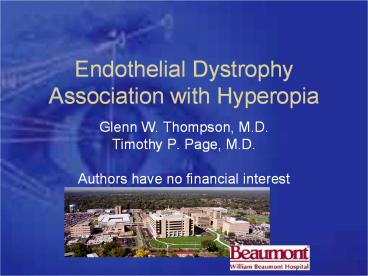Endothelial Dystrophy Association with Hyperopia - PowerPoint PPT Presentation
Title:
Endothelial Dystrophy Association with Hyperopia
Description:
Endothelial Dystrophy Association with Hyperopia Glenn W. Thompson, M.D. Timothy P. Page, M.D. Authors have no financial interest Purpose Compare the incidence of ... – PowerPoint PPT presentation
Number of Views:70
Avg rating:3.0/5.0
Title: Endothelial Dystrophy Association with Hyperopia
1
Endothelial Dystrophy Association with Hyperopia
- Glenn W. Thompson, M.D.
- Timothy P. Page, M.D.
- Authors have no financial interest
2
Purpose
- Compare the incidence of hyperopia, and
refractive error of patients with and without
guttata and Fuchs dystrophy - Pitts and Jay first described the association
between Fuchs dystrophy and hyperopia in 19901 - Their Fuchs patients had MRx of 2.48 compared
to -.31 for controls, which was statistically
significant - Fuchs patients also had shorter axial lengths
and shallower anterior chambers
1. Pitts JF, Jay JL. The association of Fuchs
corneal endothelial dystrophy with axial
hypermetropia, shallow anterior chamber, and
angle closure glaucoma. Br J Ophthalmol
199074601-604.
3
Purpose Continued
- We wanted to specifically look at hyperopia
related to the severity of Fuchs dystrophy - Stage I cornea guttata without stromal edema
- Stage II cornea guttata with stromal edema
- Stage III stromal edema with epithelial edema
and bullae, which may lead to subepithelial
fibrosis
4
Methods
- Study Population
- Cases 130 patients with 248 eyes
- Controls 127 patients with 241 eyes
- Outcome Measures
- Age
- Gender
- Family history of corneal dystrophy
- Refraction including a chart review for myopic or
hyperopic shifts - Visual acuity
- Quantification of central corneal guttata
- Presence of corneal edema
5
Exclusion Criteria
- Previous cataract surgery with IOL was excluded
unless preoperative data was available - History of refractive surgery including RK, PRK,
and LASIK - Aphakic patients
- Significant opacification of the ocular media
preventing determination of refractive error
6
Demographic Data p-value of Wilcoxon
Two-Sample Test using the t Approximation
Study Group 130 pts, 248 eyes Control Group 127 pts, 241 eyes p-value
Age (mean standard deviation) 65.30 12.64 59.16 14.34 0.0014
Visual Acuity (logMAR) (mean standard deviation) 0.30 0.36 0.16 0.25 lt0.0001
Visual Acuity (Snellen) 20/40 20/30
MaleFemale 27 73 41 59
Family History 1 0
7
Results
- A statistically significant greater proportion of
study group eyes had a hyperopic spherical
equivalent than the control group eyes
(p-valuelt0.0001). - Mean spherical equivalent
- Cases 0.60 SD 2.65
- Controls -0.52 SD 2.44
- p-value lt 0.001
8
Refractive Results p-value of Two-tailed
Fishers Exact Test p-value of Wilcoxon
Two-Sample Test using the t Approximation
Study Group Control Group p-value
Spherical Equivalent (prior to correction of myopic shift) (mean standard deviation) 0.60 2.65 -0.52 2.44 lt0.001
Spherical Equivalent (after correction of myopic shift) (mean standard deviation) 0.65 2.57 -0.42 2.44 lt0.001
Percent hyperopic (prior to correction of myopic shift) 61 41 lt0.0001
Percent hyperopic (after correction of myopic shift) 64 42 lt0.001
9
Fuchs Dystrophy Severity p-value of
Two-tailed Fishers Exact Test lt0.0001
Proportion hyperopic () Spherical Equivalent (mean standard deviation)
Stage I 138/216 (64) 0.67 2.56
Stage II 17/28 (61) 0.70 3.21
Stage III 3/4 (75) 1.81 2.82
10
Conclusions
- There is a significant association between the
incidence of hyperopia and both the presence and
degree of Fuchs dystrophy - This is a large study of a primarily Caucasian
suburban population - Limitations of this study include the unmatched
case and control age and visual acuity































